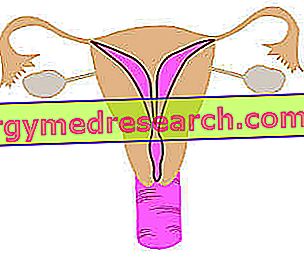Generality
The septum uterus is a congenital anomaly of the uterus.
Like the bicorne uterus and the didelfus uterus, it represents one of the seven anomalies of the Müllerian ducts, pathologies with unknown causes originating from a developmental error during embryonic life.

Figure: representation of a septum uterus.
From the site: mulleriananomalies.blogspot.it
The presence of the uterus septum is often the cause of unpleasant consequences during a pregnancy (spontaneous abortion, premature birth and ill positioning of the fetus).
For an accurate diagnosis, the pelvic exam is not enough. In fact, instrumental assessments are necessary.
If the presence of the uterus septum has no effect on the ability to have children, doctors prefer not to intervene. If instead the aforementioned uterine anomaly repeatedly hinders any attempt at pregnancy, they consider it appropriate to operate surgically.
Short reference to the uterus
Unequal and hollow, the uterus is the female genital organ that serves to receive the fertilized egg cell (that is, the future fetus) and to guarantee its correct development during the 9 months of pregnancy.

Figure: depiction of a normal uterus. According to the most accurate descriptions, the uterus presents two other areas, in addition to the body of the uterus and the uterine cervix: they are the isthmus of the uterus and the fundus (or base) of the uterus. The isthmus of the uterus is the narrowing that divides the body and the neck of the uterus. The fundus (or base of the uterus) is the upper portion of the body, located above the imaginary line that connects the two fallopian tubes. It is rounded in shape and protrudes forward.
It resides in the small pelvis, precisely between bladder (anteriorly), rectum (posteriorly), intestinal loops (superiorly) and vagina (inferiorly).
During the lifetime, the uterus changes its shape. If up to the prepubertal age it has an elongated appearance similar to a glove finger, in adulthood it looks a lot like an inverted (or upside down) pear, while in the post-menopausal phase it gradually reduces its volume and is crushed.
From a macroscopic point of view, doctors divide the uterus into two distinct main regions: a larger and larger portion, called the uterus body (or uterine body ), and a narrower portion, called the cervix (or cervix ). The uterine cervix protrudes, to a minimum extent, inside the vagina: it is the so-called "tench snout".
| Measurements and weight of the uterus in an adult woman. | |
| Medium length | 7-8 centimeters |
Transverse diameter | 4-5 centimeters |
Antero-posterior diameter | 4 centimeters |
Weight | 60-70 grams |
What is the uterus septum?
The septum uterus is a congenital malformation of the uterus, characterized by the presence, in the uterine body, of a longitudinal partition wall. Made up of muscle-fibrous tissue, this dividing wall originates from the bottom of the uterus and projects towards the cervix.
The uterus septum can be complete or incomplete (subset). If it is complete, it means that it separates the entire cavity created by the body of the uterus; if it is incomplete, it means that the subdivision is only partial.
In most women, the uterus septum is partial.
The condition of uterus septum has a congenital nature, ie it is present from birth.
SPECIAL FEATURES? OF THE WHOLE COMPLETE SET
In women with a complete septal uterus, the dividing wall reaches the cervix - giving rise to the condition known as "double cervix" - and sometimes even up to the vagina; in the latter case, the medical term that describes this situation is "double vagina".
Causes
To learn more: Symptoms Uterus Septum
Despite years of studies, doctors and scientists have not yet succeeded in establishing what the precise causes of uterus septum are.
The only certain information, obtained during their research, concerns the basic pathophysiological mechanism.
PATHOPHYSIOLOGY
According to the findings of the various studies on the subject, the uterus septum derives from a wrong development of the two paramesonephric ducts, during embryogenesis (NB: this confirms what previously stated, with respect to the fact that the uterus septum is a congenital condition) .
The paramesonephric ducts, or ducts of Müller, are small genital ducts, present in the embryo, which with the stimulation by the estrogens unite and give rise to the uterus, the fallopian tubes and the vagina.
In other words, the paramesonephric ducts are the embryonic structures from which some of the main female genital organs are born.
In the case of the uterus septum, for reasons that are still unknown, the embryonic evolutionary process that the Müller ducts face is not successful and generally has a main and a related effect:
- Main effect: the lack of absorption of the muscular-fibrous wall, which separates the body of the uterus and the cervix into two. In this regard, it is important to remind the reader that the dividing wall is present in the wombs of all women in an embryonic stage; however this dividing wall disappears during the correct maturation process of the paramesonephric ducts.
- Related effect: the formation of two vaginas.
Given the involvement of Müller's scholars, doctors and experts include the uterus septum among the so-called " Müllerian duct anomalies ". To be precise, it represents the class V Müllerian anomaly.
Also in the male embryo the paramesonephric ducts are present, however these regress around the 11th week of development, as they do not undergo the same estrogenic stimulations that occur in the female embryo.
NB: Readers who are part of the Müllerian duct anomalies are also reminded of uterine agenesis (class I), the unicorne uterus (class II), the didelfus uterus (class III), the bicorne uterus (class IV), the arched uterus (class VI) and the T-shaped uterus (class VII).
Epidemiology
The precise incidence of the uterus septum is not known. In the opinion of the doctors, it is most likely underdiagnosed, as - as will be seen in the next chapter - it is sometimes asymptomatic and without consequences.
According to various clinical observations, gynecologists believe that it is the anomaly of the most common Müllerian ducts, with as many as 55% of the cases. Furthermore, it also appears to be the uterine abnormality most frequently associated with reproductive problems: in fact, it is found in approximately 67% of cases.
Symptoms and consequences
The condition of uterus septum is generally not responsible for any particular symptom, to the point that often female carriers are unaware that they are.
Nevertheless, it can still cause problems at the time of pregnancy.
These problems include:
- Spontaneous abortion (or involuntary termination of pregnancy) . According to some scientific and statistical studies, the presence of a uterus septum raises the risk of miscarriage by at least a good 60%.
In most cases, involuntary termination of pregnancy occurs during the first trimester of gestation.
- Preterm birth (or premature birth) . Doctors define a birth as premature, when it takes place at least three weeks before the fortieth and last week of pregnancy. The negative effects that a preterm birth can have on the unborn child depend on how long the birth takes place, compared to the presumed date. In simpler words, the child is born first and the health conditions are more serious. This is quite clear, given that the stay in the uterus serves the fetus to develop properly.
Doctors classify a preterm birth based on when it occurs: it is late, if it occurs between the 34th and 37th week of gestation; it is serious, if it occurs between the 25th and 33rd week of pregnancy; it is extreme, if the child is born before the 25th.
From a pathophysiological point of view, the lack of adequate growth space is the reason for the early birth of the fetus in a woman with a uterus septum. In fact, two separate uterine bodies (even if partially) are insufficient, for capacity, to host a developing child.
Currently, the precise frequency of preterm parts in septal uterus is not known.
- Incorrect position of the fetus . The most common wrong positions are two: the podalica and the transverse (or transversal). A child is in a breech position when he presents his feet instead of his head towards the exit; while it is in a sideways position when it faces one of the two shoulders towards the exit.
As before, it is not known in how many women with uterus septum the fetus takes a wrong position.
ASSOCIATIONS
From the observation of numerous clinical cases, doctors and gynecology experts have concluded that, often, the uterus septum is associated with particular pathological conditions, such as:
- Some kidney abnormalities . The most common anomaly is renal agenesis, that is the lack of one (unilateral agenesis) or both (bilateral agenesis) the kidneys.
- Some skeletal defects . They are rare, but possible.
Diagnosis
Doctors can identify the presence of the uterus septum by means of: a hysterography, a nuclear magnetic resonance, a hysterosalpingography, a hysteroscopy and a three-dimensional ultrasonography.
The simple pelvic exam has limitations.
sonohysterography
Sono-hysterography is a gynecological ultrasound, which serves to visualize the uterine cavity from within; this exam is very useful in identifying malformations of the uterus, endometrial thickening, polyps and fibroids.
As with any ultrasound examination, the doctor uses an ultrasound probe, which leads into the uterus through the vagina (transvaginal route).
Before this operation, he must inject a special sterile physiological solution into the uterine cavity, in order to stretch the surrounding walls (NB: with stretching, it is intended to expand the internal space).
NUCLEAR MAGNETIC RESONANCE
Nuclear magnetic resonance ( NMR ) is a painless diagnostic test that allows the visualization of the internal structures of the human body without the use of harmful ionizing radiation (X-rays). In fact, the equipment in use creates magnetic fields, capable of emitting signals that a special detector transforms into images.
hysterosalpingography
Hysterosalpingography is a diagnostic procedure of the radiographic type, which involves the exposure of the patient to a (minimum) dose of X-rays. Through its realization, the doctor can assess the morphological aspect of the uterine cavity and the fallopian tubes.
For the visualization of the interested areas, a particular contrast liquid, opaque to X-rays, is needed, which an operator (or the doctor himself) injects specifically into the uterine cervix.
For cases of uterus septum (or presumed such), hysterosalpingography is a partially reliable test, as the
resulting resemble those that produces the presence of a bicornor uterus.
Because X-rays are radiation harmful to health, hysterosalpingography is a minimally invasive diagnostic procedure.
HYSTEROSCOPY
Hysteroscopy is a diagnostic technique - but, if necessary, even operative - that allows an evaluation, from inside, of the endometrial mucosa, of the cervical cavity and of the uterus body.
For its execution, the doctor uses the hysteroscope, a special metal instrument, which is equipped with a small camera. This camera is connected to an external monitor and obviously serves to display the above mentioned regions.
The hysteroscope is inserted into the uterus via the vagina.
THREE-DIMENSIONAL ULTRASONOGRAPHY
Three-dimensional ultrasonography is a particular ultrasound, which provides images in three dimensions.
Due to the high quality of the visualization, it is a technique that is becoming increasingly popular, above all as regards the diagnosis of uterine malformations.
UTERO SETTO AND PELVICO EXAMINATION
During a pelvic exam, the finding of a double cervix and possibly even a double vagina is to be considered only as a suspicious sign of a uterus septum.
In fact, other congenital abnormalities of the uterus - one of all the didelfus uterus - present the same alterations to the genital tract.
Therefore, in these situations, the medical advice is to undergo more specific instrumental checks, such as those just described.
Treatment
If the uterus septum does not create problems during pregnancy, doctors prefer not to resort to any therapeutic treatment. If, on the contrary, the aforementioned uterine malformation hinders the possibility of having children, they opt for surgery, known as hysteroscopic metroplasty.
HYSTEROSCOPIC METROPLASTICS
Hysteroscopic metroplasty is a surgical operation that the doctor performs through a hysteroscope and removes the abnormalities inside the uterine cavity.
It requires general or spinal anesthesia and distension, by means of a special physiological solution, of the inner walls of the uterus.
The instrumentation used to remove the partition wall is multiple. In fact, the surgeon can equip the hysteroscope with micro-scissors, electrosurgery or a laser source.
Currently, hysteroscopic metroplasty is the most reliable technique that provides the best results for uterus septum (both total and incomplete).
Some of the main advantages of hysteroscopic metroplasty.
- Only one day of hospitalization is generally expected
- Absence of scars on the abdomen (NB: the insertion of the hysteroscope in the vagina does not require abdominal incisions)
- Possibility of starting a pregnancy 1-2 months after the operation
- Creation of an expanded intrauterine cavity
IMPORTANCE OF ACCURATE DIAGNOSIS
The uterus septum requires a different surgical procedure than expected in the presence of a bicornor uterus. In fact, if in the first case, the doctors must proceed with a hysteroscopic metroplasty, in the second case they must resort to the so-called Strassmann's metroplasty. Strassmann's metroplasty is a laparoscopic procedure, which involves several small incisions at the level of the abdomen.
In light of this, therefore, it is clear how important a precise diagnosis of the present uterine malformation is and why doctors must resolve even the slightest doubt with further investigations.
Prognosis
In most cases, the removal of the partition wall, located inside the uterus, is of considerable benefit. In fact, according to some statistical studies, the risk of miscarriage, in women with uterus septum subjected to surgery, is drastically reduced: from more than 60% to just under 6%.



